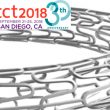This study was aimed at gaining device registration from the US Food and Drug Administration (FDA) for a polymer-free biolimus A9 drug-coated stent (BioFreedom, Biosensors). The study had two purposes: on the one hand, it meant to reproduce the results of the LEADERS FREE trial (published in 2015) in terms of safety and efficacy with<a href="https://solaci.org/en/2018/10/03/tct-2018-leaders-free-ii-polymer-free-des-in-patients-at-high-risk-for-bleeding-with-1-month-of-antiplatelet-therapy/" title="Read more" >...</a>
OCT Provides Hints About the Physiopathology Behind Very Late Stent Thrombosis
Neoatherosclerosis was frequently observed in patients who experienced very late stent thrombosis, particularly those with drug-eluting stents. In-stent plaque rupture was the most common cause of thrombosis and it usually occurred in cases in which the original procedure had been carried out while the patient was undergoing an acute myocardial infarction. Macrophage infiltration can be<a href="https://solaci.org/en/2018/09/10/oct-provides-hints-about-the-physiopathology-behind-very-late-stent-thrombosis/" title="Read more" >...</a>
New Ultra-Thin-Strut DES: Do They Outperform Second-Generation DES?
The new drug-eluting stents (DES) equipped with ultra-thin struts are showing a lower risk of target lesion failure as a result of lower rates of acute myocardial infarction and similar rates of revascularization, according to this meta-analysis soon to be published in Circulation. Such a difference is evidenced at a 1-year follow-up when compared with<a href="https://solaci.org/en/2018/07/04/new-ultra-thin-strut-des-do-they-outperform-second-generation-des/" title="Read more" >...</a>
EuroPCR 2018 | 2nd and 3rd-Generation DES for Bifurcation Lesions: Nothing New Under the Sun
This study aimed to assess the outcome of Culotte stenting with newer-generation drug-eluting stents (DES) in Medina 1, 1, 1 bifurcation lesions. The 2nd-generation device used was permanent-polymer everolimus-eluting stent Xience, a device for which there is comparatively plenty of evidence available. Alternatively, the 3rd-generation stent used was thin-strut abluminal bioresorbable-polymer everolimus-eluting stent SYNERGY. Patients with<a href="https://solaci.org/en/2018/05/31/europcr-2018-2nd-and-3rd-generation-des-for-bifurcation-lesions-nothing-new-under-the-sun/" title="Read more" >...</a>
EuroPCR 2018 | DESSOLV III: Bioabsorbable vs. Durable Polymer at 2 Years
Most drug-eluting stents are coated by a polymer that is used to contain the antiproliferative drug. Once the drug is released, the polymer remains in place and its presence has been associated with inflammation, restenosis, and neoatherosclerosis. The MiStent device features a polymer that becomes bioabsorbable once the drug has been released, which could, theoretically,<a href="https://solaci.org/en/2018/05/31/europcr-2018-dessolv-iii-bioabsorbable-vs-durable-polymer-at-2-years/" title="Read more" >...</a>
EuroPCR 2018 | BIO-RESORT: Polymer vs. Bioresorbable Polymer; Have We Reached a Plateau with DES?
This study randomized 3514 patients to a thin-strut biodegradable polymer everolimus-eluting stent (SYNERGY) vs. a sirolimus-eluting stent (ORSIRO) vs. a durable polymer zotarolimus-eluting stent (RESOLUTE INTEGRITY). The combined endpoint, the rate of target vessel failure, was similar for all three devices (8.3% for the zotarolimos-eluting stent, 6.8% for the everolimus-eluting stent, and 6.6% for the sirolimus-eluting<a href="https://solaci.org/en/2018/05/29/europcr-2018-bio-resort-polymer-vs-bioresorbable-polymer-have-we-reached-a-plateau-with-des/" title="Read more" >...</a>
Dual Antiplatelet Therapy: Less Is More for Elderly Patients
A recent meta-analysis that will be published soon in JACC Intv offers evidence of benefit derived from short-term dual antiplatelet therapy for elderly patients. This is a patient group that has always been excluded from the major trials, while remaining one of the most challenging subgroups in which to balance bleeding and ischemic risks. The<a href="https://solaci.org/en/2018/03/27/dual-antiplatelet-therapy-less-is-more-for-elderly-patients/" title="Read more" >...</a>
Complete Revascularization Is Beneficial in Acute MI with Cardiogenic Shock
Around half of all cases of ST-segment elevation acute myocardial infarction (STEMI) come alongside lesions in another vessel, for which the current strategy is complete revascularization in one or two steps. However, there are no large-scale studies analyzing patients who also present cardiogenic shock; we only have observational studies with inconclusive results influenced by several<a href="https://solaci.org/en/2018/03/16/complete-revascularization-is-beneficial-in-acute-mi-with-cardiogenic-shock/" title="Read more" >...</a>
These were the 5 most read scientific articles of January
1) The 10 Commandments of ESC’s New STEMI Guidelines The authors have given an entertaining account of the most relevant points and differences between the new STEMI guidelines and the prior ones, from 2014. Read more 2) Burnout Syndrome among Cardiologists For the first time, the American College of Cardiology (ACC) has carried out a survey on this phenomenon,<a href="https://solaci.org/en/2018/02/01/these-were-the-5-most-read-scientific-articles-of-january/" title="Read more" >...</a>
The Importance of Knowing Which Conduits Will a Surgeon Use for Revascularization
Whether a second arterial conduit improves outcomes in patients undergoing myocardial revascularization surgery is and will remain unclear until the 10-year results of the ART (Arterial Revascularization Trial) are published. Consequently, arterial conduits other than the left internal thoracic artery are seldom used in daily practice. Using a database including 126 non-federal hospitals in California, researchers<a href="https://solaci.org/en/2018/01/30/the-importance-of-knowing-which-conduits-will-a-surgeon-use-for-revascularization/" title="Read more" >...</a>









